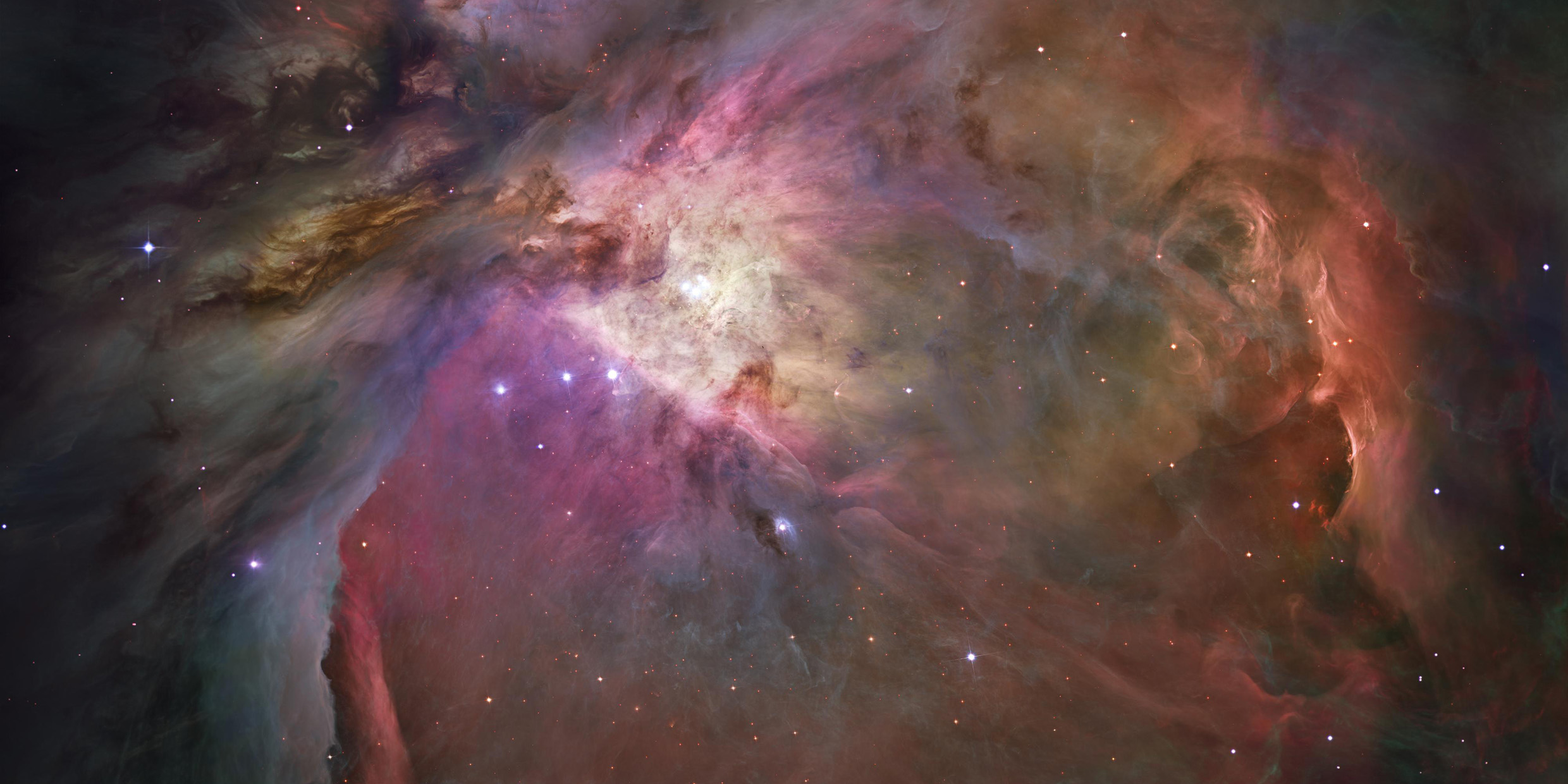Originally published 29 June 1992
On a night that is perfectly dark and clear, the naked eye can just discern the Great Orion Nebula as a patch of fuzzy white light in the sword of Orion. It might easily be mistaken for a star, but the light we see is the light of many stars, newly born, embedded in a cloud of glowing gas.
The Orion nebula is 1,500 light-years from Earth. It is the closest and brightest of the nebulas that populate the arms of the Milky Way galaxy. It is roughly spherical in shape, and big enough to hold 20,000 solar systems. There is enough hydrogen, helium, and other materials in the cloud to form 10,000 stars like our sun. The light from the nebula comes mostly from the radiation of doubly ionized oxygen (green) and the alpha radiation of ionized hydrogen (red). The gas is made to glow by the energy of hot young stars embedded in the nebula, stars only recently born of the stuff of the nebula itself.
In a moderate-sized telescope, the nebula shines with an eerie green light, and the eye sees hints of shape — like a curled, luminous hand. Four jewel-like stars, the Trapezium, glitter in the palm. This is a showpiece object for professional and amateur astronomers, and never fails to elicit “ooohs” and “ahhhs” from first-time viewers.
Long-exposure photographs of the Orion nebula reveal a stunning complex of stars in the trauma of birth, swaddled in vortices and streamers of luminous gas, knotted by gravity — a star-cradle measured by light-years and charged with the energy of creation.
The colors of the nebula are as various as the photographs. On Kodacolor 400 film, Orion’s great cloud is plum and lilac, cerulean blue and milky white. On Ektachrome 400 the nebula is apricot and red, tinted with deep ochers and browns. On Kodacolor 1000 film Orion’s nebula is mauve and amethyst, blushed with rose.
All of these colors seem to reveal some aspect of the nebula’s beauty, but most of the colors are artifacts of the film; they are not what the eye would see if we could approach the nebula and stand in its awesome light.
No one has taken more spectacular photographs of the Orion nebula than David Malin, a British-born astrophotographer at the Anglo-Australian Observatory in New South Wales. Malin is quite simply the world’s best professional photographer of the heavens. For his finest shot of the Orion nebula, he used the 1.2 meter UK Schmidt telescope at Siding Spring, Australia, to make three single-color photographs on 14-inch-square glass plates, each with a different color filter, which were combined into one color image. Filters and emulsions were chosen to give a uniform color response across the spectrum. Special masking techniques were used to bring out detail.
Malin’s portrait of the Orion Nebula reminds me of nothing so much as an etching by the mystic/artist William Blake — a portal to eternity flanked by angels with diaphanous wings. And indeed, this is a kind of portal. The hot young stars at the core of the nebula have burned away the side of their cocoon, allowing us to look deep into the furnace of creation. These stars are probably no more than 100,000 years old. We are witness to the interior of a furious workshop where gravity and fusion bring stars and planets into being.
In Malin’s photograph, the green glow that we see in a small telescope combines with the reds and blues of the typical Kodacolor print to brown and yellow the light. The image reveals peach, rose, olive, and orange — and grays banked against the black of space like ash. These are presumably the colors we would see if we approached the nebula.
Malin’s photograph of the Orion nebula appears in the June [1992] issue of Scientific American, as a small inset next to a full-page image of a tiny corner of the nebula provided by the Hubble Space Telescope. The colors are less realistic than in Malin’s photograph, but we see details never achieved before — newborn stars floating in a gaudy matrix of seething gas.
The Hubble’s Wide Field and Planetary Camera took three 10-minute exposures of the nebula, in three colors of light, and this data was assembled on Earth into one computer-generated image. The result is spectacular, but for sheer dramatic beauty computer images do not yet compete with the exquisite beauty of a glass-plate emulsion.
Each new image of the Orion nebula reveals previously unseen details of this magnificent star-spawning cloud. Together, these images shake us to the soles of our feet. The human eye is a poor explorer of the night. The color receptors in the retina of the human eye do not work well in faint light. That’s why the universe we see at night is black and white. And that’s why the Orion nebula appears to the eye as a fuzzy white dot.
As explorers of the universe, we are no longer prisoners of our biological senses. The science of astrophotography has thrown open a window on eternity. It comes as a huge surprise that the fuzzy white dot is a seething whirlpool of color, stirred by angels, spawning stars.



